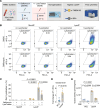Tagless LysoIP for immunoaffinity enrichment of native lysosomes from clinical samples
- PMID: 39724071
- PMCID: PMC11827837
- DOI: 10.1172/JCI183592
Tagless LysoIP for immunoaffinity enrichment of native lysosomes from clinical samples
Abstract
Lysosomes are implicated in a wide spectrum of human diseases, including monogenic lysosomal storage disorders (LSDs), age-associated neurodegeneration, and cancer. Profiling lysosomal content using tag-based lysosomal immunoprecipitation (LysoTagIP) in cell and animal models has substantially moved the field forward, but studying lysosomal dysfunction in patients remains challenging. Here, we report the development of the 'tagless LysoIP' method, designed to enable the rapid enrichment of lysosomes, via immunoprecipitation, using the endogenous integral lysosomal membrane protein TMEM192, directly from clinical samples and human cell lines (e.g., induced pluripotent stem cell-derived neurons). Isolated lysosomes were intact and suitable for subsequent multimodal omics analyses. To validate our approach, we applied the tagless LysoIP to enrich lysosomes from peripheral blood mononuclear cells derived from fresh blood of healthy donors and patients with CLN3 disease, an autosomal recessive neurodegenerative LSD. Metabolic profiling of isolated lysosomes revealed massive accumulation of glycerophosphodiesters (GPDs) in patients' lysosomes. Interestingly, a patient with a milder phenotype and genotype displayed lower accumulation of lysosomal GPDs, consistent with their potential role as disease biomarkers. Altogether, the tagless LysoIP provides a framework to study native lysosomes from patient samples, identify disease biomarkers, and discover human-relevant disease mechanisms.
Keywords: Cell biology; Genetic diseases; Lysosomes; Neurodegeneration; Neuroscience.
Conflict of interest statement
Figures






Comment in
- Purifying and profiling lysosomes to expand understanding of lysosomal dysfunction–associated diseases doi: 10.1172/JCI188507
References
MeSH terms
Substances
Grants and funding
LinkOut - more resources
Full Text Sources

